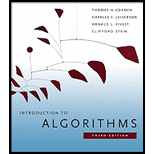
Concept explainers
(a)
To Show if there is an
(a)
Explanation of Solution
The linear inequalities that are required to satisfy be the set of constraints in the linear program. Let the function to be maximized, be a constant. Linear programs solver will fail to detect the feasible solution if the linear constraints are not feasible. Suppose linear programming solver returns the solution, thenthose linear constraints are feasible.
(b)
To Show if there is an algorithm for the linear-inequality feasibility problem, then it can be used to solve a linear-programming problem. The number of variables, linearinequalities, variable and constraint used in linear-inequality feasibility problem must be polynomial in n and m .
(b)
Explanation of Solution
To solve the linear program in standard form with some particulars such as A, b, c. That is, to maximize the equation
such that all entries of x
SubjecttoATY = T such that all entries in the y vector are nonzero. By Corollary 29.9 mentioned in the question, if x and y are feasible solutions to their respective problems, and if their objective functions are equal, then, the x and y optimal solutions and their objective functions should be equal. This can be achieved as, let ck be some nonzero entry in thec vector. If there are no nonzero entries, then the function to optimize is just the zero function, and it is exactly a feasibility question. Then, add the two linear inequalities (1) and (2) to get the equation below:
-(3)
The values the variables take, their objective functions will be equal. Lastly use these with the inequalities that are already present. Therefore, the constraints will be as follows:
Ax = b
ATy = c
The number of variables equal to n + m and a number of constraints equal to 2 + 2n + 2m , both are polynomial in n and m . So any assignment of variables that satisfy all of constraints will be a feasible solution to the problem and its dual and the respective objective functions take the same value therefore it is an optimal solution the original problem and its dual So the linear inequality feasibility solver returns a satisfying assignment.
If there is optimal solution x , an optimal solution for the dual can be obtained such that it makes the objective functions equal by theorem 29.10 mentioned in the above question. This guarantees that the two constraints added such that that the objectives of the original problem and the dual problem should be equal do not cause to change the optimal solution to the linear program.
Want to see more full solutions like this?
Chapter 29 Solutions
Introduction to Algorithms
- "Do not use AI tools. Solve the problem by hand on paper only and upload a photo of your handwritten solution."arrow_forward"Do not use AI tools. Solve the problem by hand on paper only and upload a photo of your handwritten solution."arrow_forward"Do not use AI tools. Solve the problem by hand on paper only and upload a photo of your handwritten solution."arrow_forward
- "Do not use AI tools. Solve the problem by hand on paper only and upload a photo of your handwritten solution."arrow_forwardSolve this "Do not use AI tools. Solve the problem by hand on paper only and upload a photo of your handwritten solution."arrow_forward"Do not use AI tools. Solve the problem by hand on paper only and upload a photo of your handwritten solution."arrow_forward
- "Do not use AI tools. Solve the problem by hand on paper only and upload a photo of your handwritten solution."arrow_forwardSpecifications: Part-1Part-1: DescriptionIn this part of the lab you will build a single operation ALU. This ALU will implement a bitwise left rotation. Forthis lab assignment you are not allowed to use Digital's Arithmetic components.IF YOU ARE FOUND USING THEM, YOU WILL RECEIVE A ZERO FOR LAB2!The ALU you will be implementing consists of two 4-bit inputs (named inA and inB) and one 4-bit output (named out). Your ALU must rotate the bits in inA by the amount given by inB (i.e. 0-15).Part-1: User InterfaceYou are provided an interface file lab2_part1.dig; start Part-1 from this file.NOTE: You are not permitted to edit the content inside the dotted lines rectangle. Part-1: ExampleIn the figure above, the input values that we have selected to test are inA = {inA_3, inA_2, inA_1, inA_0} = {0, 1, 0,0} and inB = {inB_3, inB_2, inB_1, inB_0} = {0, 0, 1, 0}. Therefore, we must rotate the bus 0100 bitwise left by00102, or 2 in base 10, to get {0, 0, 0, 1}. Please note that a rotation left is…arrow_forwardSolve this "Do not use AI tools. Solve the problem by hand on paper only and upload a photo of your handwritten solution."arrow_forward
- Solve this "Do not use AI tools. Solve the problem by hand on paper only and upload a photo of your handwritten solution."arrow_forward"Do not use AI tools. Solve the problem by hand on paper only and upload a photo of your handwritten solution."arrow_forwardSolve this "Do not use AI tools. Solve the problem by hand on paper only and upload a photo of your handwritten solution."arrow_forward
 Operations Research : Applications and AlgorithmsComputer ScienceISBN:9780534380588Author:Wayne L. WinstonPublisher:Brooks Cole
Operations Research : Applications and AlgorithmsComputer ScienceISBN:9780534380588Author:Wayne L. WinstonPublisher:Brooks Cole C++ for Engineers and ScientistsComputer ScienceISBN:9781133187844Author:Bronson, Gary J.Publisher:Course Technology Ptr
C++ for Engineers and ScientistsComputer ScienceISBN:9781133187844Author:Bronson, Gary J.Publisher:Course Technology Ptr C++ Programming: From Problem Analysis to Program...Computer ScienceISBN:9781337102087Author:D. S. MalikPublisher:Cengage Learning
C++ Programming: From Problem Analysis to Program...Computer ScienceISBN:9781337102087Author:D. S. MalikPublisher:Cengage Learning


